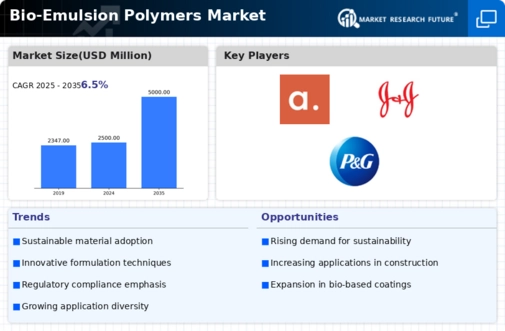Market Analysis
In-depth Analysis of Bio Emulsion Polymers Market Industry Landscape
The Bio-Emulsion Polymers Market is undergoing dynamic changes, driven by various factors that influence its growth trajectory.
Environmental Concerns and Sustainable Practices: A key driver in the market dynamics of bio-emulsion polymers is the increasing emphasis on environmental concerns and sustainable practices. As awareness of the ecological impact of traditional polymers grows, there is a rising demand for bio-based alternatives. Bio-emulsion polymers, derived from renewable resources, offer a sustainable solution and contribute to reducing the environmental footprint, influencing market dynamics.
Growing Popularity of Water-Based Polymers: Bio-emulsion polymers are often water-based, making them environmentally friendly compared to solvent-based alternatives. The market dynamics are shaped by the growing popularity of water-based polymers, driven by regulatory support for low-VOC (volatile organic compound) products and the desire for eco-friendly solutions across various industries.
Innovations in Formulations: Ongoing research and development activities in the field of bio-emulsion polymers play a crucial role in shaping market dynamics. Innovations in formulations, including improved stability, enhanced performance, and compatibility with diverse applications, influence consumer preferences and industry standards. These innovations contribute to the dynamic nature of the market by opening up new possibilities and applications.
End-User Industries: The performance of end-user industries, such as paints and coatings, adhesives, textiles, and construction, directly impacts the bio-emulsion polymers market dynamics. For example, in the coatings industry, the shift towards environmentally friendly and sustainable products drives the demand for bio-based polymers. Understanding the specific needs of these industries is essential for market players to align their strategies with market demands.
Regulatory Landscape: Market dynamics are significantly influenced by the regulatory landscape. Stringent regulations on the use of certain chemicals, especially those contributing to environmental pollution, propel the adoption of bio-emulsion polymers. Compliance with regulations becomes a key factor shaping market dynamics, prompting manufacturers to adapt and innovate to meet environmental standards.
Competitive Dynamics: The market dynamics of bio-emulsion polymers are shaped by the competitive landscape, including key players, market share, and strategic initiatives. As companies strive to differentiate their products and gain a competitive edge, market trends are influenced by factors such as mergers, acquisitions, and collaborations. The competitive dynamics create an environment where innovation and product differentiation are key drivers.
Consumer Preferences for Sustainable Products: Changing consumer preferences towards sustainable and eco-friendly products contribute to the market dynamics. The demand for bio-emulsion polymers is driven by a conscious consumer base seeking products that align with their environmental values. Market players need to be attuned to these preferences to effectively position and market their bio-based polymer products.
Cost Competitiveness: The cost competitiveness of bio-emulsion polymers compared to traditional polymers is a significant factor in market dynamics. As manufacturing processes and economies of scale improve, the cost gap between bio-based and conventional polymers narrows. This influences pricing strategies and market penetration, affecting the overall dynamics of the bio-emulsion polymer market.
Technological Advancements: The continuous evolution of technologies related to bio-emulsion polymers contributes to market dynamics. Advancements in production processes, the development of novel bio-based polymers, and improvements in performance characteristics influence the market. These technological strides drive innovation, impacting product capabilities and market competitiveness.
Global Economic Factors: Economic trends, both globally and regionally, play a significant role in the bio-emulsion polymers market dynamics. Fluctuations in currency exchange rates, economic stability, and overall industrial growth influence the demand for bio-based polymers in various sectors. Adapting to economic shifts is crucial for market players to navigate and succeed in this dynamic market.






Leave a Comment